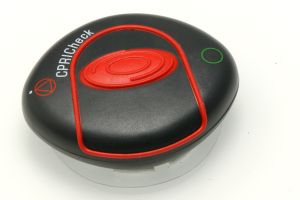How can first responders expeditiously diagnose a cardiovascular arrest of an unconscious casualty? The difficulty of a reliable diagnosis is a problem long known in emergency medicine. First responders often are uncertain and hesitate to start the ventilation measures crucial to survival. A first aid sensor developed by Karlsruhe Institute of Technology (KIT) now informs first responders rapidly and reliably about the cardiovascular status of injured persons. The sensor has been launched by a KIT spin-off.
The sensor that has the size of a walnut is called “CPR|Check“ by Dr. Marc Jäger from the KIT Institute of Biomedical Engineering. Using the first aid sensor, also laymen can reliably diagnose a cardiovascular arrest of a casualty. When the first responder applies the sensor to the throat of the patient, the device analyzes blood flow to the brain and breathing. This is a highly valuable first diagnosis for the responder. After ten seconds already does the responder know whether the injured person has to be ventilated.
“Now, we can use the valuable first minutes which so far have often elapsed because first responders are not sure about their diagnosis,” says Jäger. “Every minute without cardiopulmonary resuscitation makes the probability of survival decrease by 10%. Ten minutes after cardiac arrest, there are usually hardly any chances of survival.”

The first aid sensor has about the size of a walnut. (Photo: Marco Gerber)
The rapid diagnosis works, because the sensor measures pulse and respiration on the throat at the same time. Lifting and lowering of the chest or belly during breathing and the blood circulating in the veins lead to periodic mechanical changes at the body surface. The device detects these smallest changes.
The basic idea for this instrument dates back to the year 2004. In 2009, the KIT scientist developed the first prototype. In February 2010, Jäger founded the spin-off neocor GmbH together with partners. The way from innovation to marketable product was marked by two clinical studies. Finally, the instrument was licensed as a medical product.
The project is funded by the Federal Ministry of Economics and Technology under the EXIST research transfer program. This funding program supports excellent research-based foundation projects associated with a large expenditure and risky development activities.
Further information can be found at www.neocor.de.
In close partnership with society, KIT develops solutions for urgent challenges – from climate change, energy transition and sustainable use of natural resources to artificial intelligence, sovereignty and an aging population. As The University in the Helmholtz Association, KIT unites scientific excellence from insight to application-driven research under one roof – and is thus in a unique position to drive this transformation. As a University of Excellence, KIT offers its more than 10,000 employees and 22,800 students outstanding opportunities to shape a sustainable and resilient future. KIT – Science for Impact.

_72.jpg)